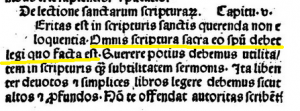I have always been fascinated by early Christian readings of pre-Christian texts. The big ones are, of course, the Iliad, the Odyssey, and the Aeneid. For a long time, many Christians read the Aeneid as a kind of Christian allegory with Aeneas as a Christ-figure, as if he were a foreshadowing of Christ.
But I just stumbled across a very vivid (bizarre?) Christian reading of Homer. This comes from Mehodius (d. 311), an early Christian bishop, who wrote many works. Only one survives–his Symposium on Virginity. It’s known by many titles: On Virginity, On Chastity, The Banquet of the Ten Virgins, Symposion e peri hagneias. In this book, Methodius depicts a long conversation between ten Christian virgins who talk about how great a virtue virginity is. The link to
At one point in the conversation, when the virgin Thekla is speaking about fleeing to the wilderness away from temptation, fighting the spiritual battle and Christ’s victory. She quotes, surprisingly, the Iliad:
Lion in front, but dragon all behind,
And in the midst a she-goat breathing forth
Profuse the violence of flaming fire.
Her slew Bellerophon in truth. And this
Slew Christ the King; for many she destroyed,
Nor could they bear the fetid foam which burst
From out the fountain of her horrid jaws; (Source)
For those of us who have not memorized Homer, this comes from Iliad Book 6, Lines 181-183. But of course, you’re saying like I was, “How could ‘Christ the King’ be in the Iliad?” Here is the Iliad text from the Chicago Homer site (minus text-critical notes):
IL.6.181 πρόσθε λέων, ὄπιθεν δὲ δράκων, μέσση δὲ χίμαιρα,
IL.6.181 lion-fronted and snake behind, a goat in the middle,IL.6.182 δεινὸν ἀποπνείουσα πυρὸς μένος αἰθομένοιο,
IL.6.182 and snorting out the breath of the terrible flame of bright fire.IL.6.183 καὶ τὴν μὲν κατέπεφνε θεῶν τεράεσσι πιθήσας.
IL.6.183 He killed the Chimaira, obeying the portents of the immortals.IL.6.184 δεύτερον αὖ Σολύμοισι μαχέσσατο κυδαλίμοισι:
IL.6.184 Next after this he fought against the glorious Solymoi,IL.6.185 καρτίστην δὴ τήν γε μάχην φάτο δύμεναι ἀνδρῶν.
IL.6.185 and this he thought was the strongest battle with men that he entered;
The key line is 183 – “he killed the Chimaira.” You might be searching the Greek for the word Chimaira and not finding it, that’s because it is back at line 179. Here’s another translation of this text from William Cowper (1791):
Lion in front, but dragon all behind,
And in the midst a she-goat breathing forth
Profuse the violence of flaming fire.
Her, confident in signs from heaven, he slew.
Next, with the men of Solymæ he fought,
Brave warriors far renown’d, with whom he waged,
You might be thinking, “What’s the big deal? So an ancient Christian bishop re-wrote a line of Homer in the midst of an ascetical treatise. What of it?” Well, I don’t know the entire story, and hopefully there’s a dusty tome waiting for me in a library that explains all of this, but I think it illustrates profoundly how a Christian worldview shaped the all of the reading of the ancients. Their perspective was so shaped, so molded by the sacred text of Scripture, that all texts have the ability to be sacred by being re-read through a Christian lens. To me this “reading procedure” is bothersome, remarkable precisely because it was so natural for them–and I think, very unnatural for us. It is a kind of “reading against” the text, almost deconstruction. And yet there is something so beautiful about it–to be able to look into Homer and see Christ, to look at any landscape and find flowers.
I’ll report back if I find more examples of this Christian re-reading of the ancient epics.


